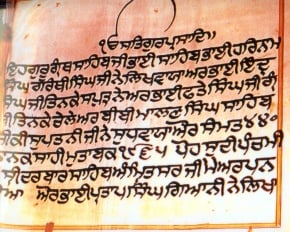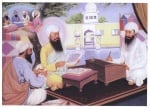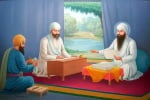Adi Granth
Adi Granth: literally means "the first book." This is the early compilation of the Sikh Scriptures by Guru Arjan Dev Ji, the fifth Sikh Guru, in 1604. This Granth (Book) is the Holy Scripture of the Sikhs. The tenth Sikh Guru, Guru Gobind Singh Ji added further holy Shabads to this Granth during the period of 1704 to 1706. Then in 1708, before taking leave for his heavenly abode, Guru Gobind Singh Ji affirmed the Adi Granth as the perpetual Guru of the Sikhs and the Granth then became known as the Sri Guru Granth Sahib Ji.
Important Milestones
- 30 August 1604: Completion of Adi Granth
- 1 September 1604: Adi Granth installed for the first time at Harimander Sahib by Guru Arjan Dev ji
- 1705: The Damdama Sahib Bir was completed by Guru Gobind Singh from memory.
- 20 October 1708: Installation of the Guru Granth Sahib as eternal Guru
Please see Sri Guru Granth Sahib for full details
The original copy of the scripture, called Adi Granth, compiled and authenticated by Guru Arjan Dev still exists today and is kept at Kartarpur which is a town about 15 km. north west of the city of Jalandhar, Panjab, India. This is the only Holy Scripture in the world which was written by the founders of the religion during their lifetime. All other holy scriptures were completed after their founders had left for their heavenly abodes. Further, this is the only holy scripture that can be considered a "universal Granth" because it contains the hymns of both Hindu and Muslim saints.
Compilation of Adi granth
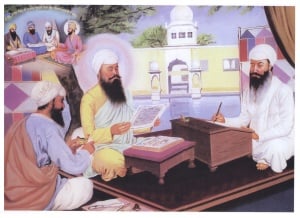
One of the classic simplifications of Sikh history pertains to the preparation of the sacred scripture, the Guru Granth Sahib. The event is generally described in the briefest terms. The Holy Volume was compiled by Guru Arjun (AD 1563-1606) and the first copy was calligraphed by Bhai Gurdas at his dictation — this is all we learn from most of the sources. What amount of planning, minute attention to detail and went into this work is slurred over.
An old text which gives some detailed information is the "Gurbilas Chhevin Patshahi". Written in A.D. 1718, this, in fact, is the oldest source. Although it does not go into the technical and literary minutiae, it narrates the entire process from the beginning of the transcription of the Holy Volume to its installation in the newly built Harimandir Sahib at Amritsar.
Why Guru Arjun undertook the task is variously explained. One commonly accepted assumption is that the codification of the Gurus' compositions into authorized volume was begun by him with a view to preserving them from garbling by schismatic groups and others. According to the Mahima Prakash (A.D. 1776), he set to work with the announcement: "As the Panth (Community) has been revealed unto the world, so there must be the Granth (Book), too."
Bani included in the Granth
The "Bani", Gurus inspired utterance, had always been the object of highest reverence for the Sikhs as well as for the Gurus themselves. It was equated with the Guru himself. "The bani is the Guru and the Guru bani" sang Guru Ram Das in measure Nat Narain. By accumulating the canon, Guru Arjun wished to affix the seal on the sacred word. It was also to be the perennial fountain of inspiration and the means of self-perpetuation for the community.
Guru Arjun called Bhai Gurdas to his presence and expressed to him the wish that the compositions of the Gurus as well as those of some of the saints and sufis be collected. Massages were sent to the disciples to gather and transmit to him the hymns of his predecessors. Baba Mohan, son of Guru Amar Das, Nanak III, had two manuscript collections of the Gurus' hymns inherited from his father.
Bhai Gurdas travelled to Goindwal to bring these pothis but the owner refused to see him. Bhai Buddha, one of the oldest Sikhs from Guru Nanak's days, was similarly turned away from his door. Then Guru Arjun went himself. He sat at the street below Mohan's attic serenading him on his tambura. Mohan was disarmed to hear the hymn. He came downstairs with the pothis and presented these to the Guru. As says the Gurbilas, the pothis were placed on a palanquin bedecked with precious stones. The Sikhs carried it on their shoulders and Guru Arjun walked behind barefoot. He refused to ride his horse, saying that the pothis were the very spirit of the four Gurus — his predecessors.
The journey with the pothis
The cavalcade broke journey at Khadur Sahib to make obeisance at shrines sacred to Guru Angad. Two kos from Amritsar, it was received by Hargobind, Guru Arjun's young son, accompanied by a large number of Sikhs. He bowed at his father's feet and showered petals in front of the pothis. Guru Arjun, Hargobind, Bhai Gurdas and Bhai Buddha now bore the palanquin on their shoulders and marched towards Amritsar, led by musicians, with flutes and drums.
In Amritsar, Guru Arjun first went to the Harimandir Sahib to offer karah prasad in gratefulness. To quote the Gurbilas again, an attractive spot in the thick of a forest on the outskirts of Amritsar was marked out by Guru Arjun. So dense was the foliage that not even a moonbeam could pray into it. It was like Panchbati itself, peaceful and picturesque. A tent was hoisted in this idyllic setting. Here Guru Arjun and Bhai Gurdas started work on the sacred volume.
The Inscription of the Granth
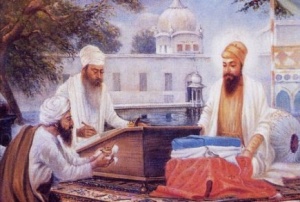
The making of the Granth was not an easy task. It involved sustained labour and a rigorous intellectual discipline. Selections had to be made from a vast amount of material. Besides the compositions of the four preceding Gurus and the Guru Arjun who himself was a poet with a rare spiritual insight, there were songs and hymns by saints, both Hindu and Muslim. What was genuine had to be sifted from what was counterfeit. Then the selected material had to be assigned to appropriate musical measures and transcribed in a minutely laid out order.
Guru Arjun carried out the work with extraordinary exactness. He arranged the hymns in thirty different ragas, or musical patterns. A precise method was followed in setting down the compositions. First came shabads by the Gurus in the order of their succession. Then came hands, vars, and other poetic forms in a set order. The compositions of the Gurus in each raga were followed by those of the Bhaktas in the same format. Gurmukhi was the script used for the transcription.
A genius, unique in spiritual insight and not unconcerned with methodological design, had created a scripture with an exalted mystical tone and a high degree of organization. It was large in size—nearly 7,000 hymns, comprising compositions of the first five Sikhs Gurus and fifteen Bhaktas and sufis from different parts of India, including Shaikh Farid, Kabir and Ravidas.
The Granth completed
The Sacred Volume consisted of 974 leaves, or 1948 pages, 12" X 8", with several blank ones at the end of a raga when there were not shabads enough to fill the section assigned to it. The site of these marvellous labours is now marked by a shrine called Gurdwara Ramsar.
The completion of the Granth Sahib was, says the "Gurbilas", celebrated with much jubilation. In thanksgiving, karah prasad was prepared in huge quantities. Sikhs came in large numbers to see the Holy Book. They rejoiced in their hearts by a sight of it and bowed before it in veneration. Among the visitors was Bhai Banno, who had led a group of Sikhs from Mangat, in western Punjab.
Binding the Granth
Guru Arjun, who knew him as a devoted Sikh, instructed him to go to Lahore and have the Book bound. Banno sought the Guru's permission to be allowed to take the Granth Sahib first to Mangat for the Sikhs there to see it. The Guru allowed this, but enjoined him not to tarry (stay any longer) at Mangat, or at any other place, more than a night.
As Bhai Banno left Amritsar with his sacred charge, it occurred to him to have a second copy transcribed. The first copy, he argued, would remain with the Guru. There must be an additional one for the sangat. The Guru's direction was that he should not stay longer than one night at a place, but he had said nothing about the time to be spent on the journey. So he proceeded with his plans and sent a Sikh to purchase paper.
He proposed to his companions that they should travel by easy marches of five miles a day. The time thus saved was utilized in transcribing the holy text. Sikhs wrote with love and devotion and nobody shirked his duty whether it was day or night. By the time they reached Lahore, the second copy was ready. But Banno had added to it some apocryphal texts. He had both volumes bound and returned to Amritsar as fast as he could.
The Adi Granth arrives
At Amritsar, he was received with due ceremony, though Guru Arjun was not a little surprised to see two volumes instead of one. Bhai Banno spoke truthfully: "Lord, there is nothing that is hidden from you. This second copy I have had made for the sake of the sangat" But the Guru put his seal only on the volume written by Bhai Gurdas's hand. He enjoined the Sikhs to own the Granth equal with the Guru and make no distinction between the two. "He who would wish to see the Guru, let him see the Granth. He who would seek the Guru's word, let him read the Granth with love and attention."
Guru Arjun asked his Sikhs where the Granth Sahib be installed. Bhai Buddha said, "You are omniscient, Master! But there is no place more suitable than the Harimandir." The Guru was happy to hear these words "like one who has sighted the new moon." He then recited the praise of the Harimandir: "There is nothing like it in all the three worlds. Harimandir is like the ship—the means for the people to cross over the worldly ocean triumphantly. A new joy pervades here every day. A sight of it annuls all sins."
The Reverence and Respect
It was decided to spend the night at Ramsar and return to Amritsar the next morning. The Granth Sahib rested on a seat under the canopy, whereas the Guru and the Sikhs slept on the ground. A disciple had to be chosen to take charge of the Granth Sahib. As says the Gurbilas, Guru Arjun lay awake through the night reflecting on the question. His choice formally fell on old Bhai Buddha whose devotion was universally applauded.
As they awoke, the Guru and his Sikhs made ablutions in Ramsar. The former there upon practised his wonted meditation. At dawn, the entire sangat marched towards Harimandir. Bhai Buddha carried the Holy Book on his head and Guru Arjun walked behind swinging the whisk over it. Musicians sang shabads. Thus they reached the Harimandir. The Granth Sahib was ceremonially installed in the centre of the inner sanctuary on Bhadon Sudi 1, 1661 sK/September 1, 1604. Bhai Buddha opened it with reverence to obtain from it the divine command, as Guru Arjun stood in attendance behind.
The following hymn was read as God's own announcement for the occasion:
"He Himself hath succoured His saints in their work, He himself hath come to see their task fulfilled. Blessed is the earth, blessed the tank. Blessed is the tank with amrit filled. Amrit overfloweth the tank: He hath had the task completed; Eternal is the Perfect Being, His praises Vedas and Puranas sing. The Creator hath bestowed on me the nine treasures, and all the charisms, No lack do I suffer now. Enjoying His largesse, bliss have I attained, Ever-expanding is the Lord's bounty."
The Granth installed
Guru Arjun directed that during daytime the Holy Book should remain in the Harimandir and by night, after, Sohila was read, it should be taken to the room he had built for himself. As evening advanced by two watches, Bhai Buddha recited Sohila and made the concluding ardas or supplication. The Granth Sahib was closed and wrapped in silks. Bhai Buddha held it on his head and marched towards the chamber indicated by Guru Arjun. The Guru led the sangat singing hymns.
The Granth Sahib was placed on the appointed seat, and the Guru slept on the ground by its side. Daily, in the small hours of the morning as the stars twinkle in the pool below, the Holy Book is taken out in state to the Harimandir and brought by night to rest in the room marked for it by Guru Arjun. The practice continues to this day. But the volume is not the same. That original copy was taken to Kartarpur when Guru Arjun's successor, Guru Hargobind, left Amritsar in 1634. There it passed into the possession of his grandson, Dhir Mall. It has since remained in that family.
- The above section with thanks to www.sikhlionz.com by Fauja Singh "The city of Amritsar"
In the News
'Year-long Adi Granth anniversary celebrations - Tribune News Service New Delhi, August 23, 2004
The Centre has decided to hold year-long celebrations to mark the 400th anniversary of the installation of Adi Granth in the Shri Harmandir Sahib.
Prime Minister Manmohan Singh today chaired the first meeting of the National Committee to celebrate the 400th anniversary. It was decided to constitute a programme committee with Union Culture Minister, S Jaipal Reddy, as its chairperson, to chalk out the programmes. Dr. Manmohan Singh will visit Amritsar on September 1 to take part in the 400th anniversary functions. President APJ Abdul Kalam will also visit Amritsar.
Addressing committee members, Dr. Manmohan Singh said the Adi Granth was a unique text that brings together the hymns of many revered Gurus, devoted Bhaktas, and Sufi saints. “It is a sacred text that mirrors the many concerns of our Gurus, sages, and wise men who had, at the care of their heart, genuine concern for the welfare of humanity and for its spiritual regeneration.”
He said Adi Granth’s central message was of humanism and universal brotherhood. It is a source of inspiration for those who seek social justice, the equality of all people, the empowerment of women, and of the under privileged.
The Prime Minister said he was happy that several steps were being contemplated to celebrate the anniversary of the Adi Granth and to spread its message of Universal Brotherhood.
Assuring assistance by the Centre, he said it had been proposed to set up a national institute or a research centre for the Sri Guru Granth Saahib Ji Studies as well as seminars and conferences which will establish chairs of learning and bringing out a wide range of publications.
Dr. Manmohan Singh said, “Adi Granth teaches to develop a concern for the environment, preaching the value of living in harmony with nature.” “It is for those reasons that I believe the text has remained alive as a guide to all, those who value these fundamental principles of humanism and human integrity,” he said.
The Prime Minister said there can be no better way to honour such a sacred text than to learn to live by its teaching, live in peace and harmony with one another and with nature.
The meeting was attended by Punjab Chief Minister Amarinder Singh, Delhi Chief Minister Sheila Diksh-it, Leader of the Opposition in the Rajya Sabha Jaswant Singh, Andhra Pradesh Governor S S Barnala, CPI(M) leader Harkishan Singh Surjeet, and academics and religious leaders.
See also
Additional Resources
Gallery
- Picture Gallery
